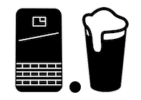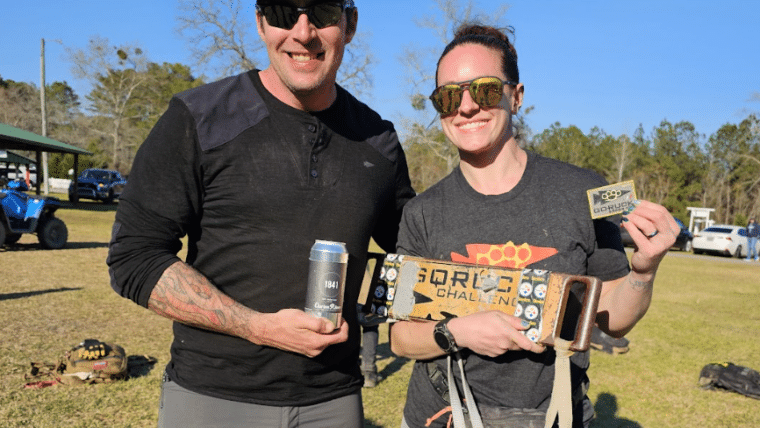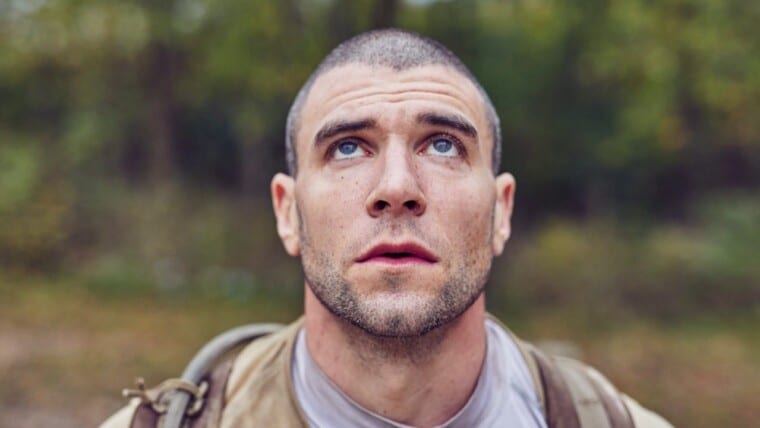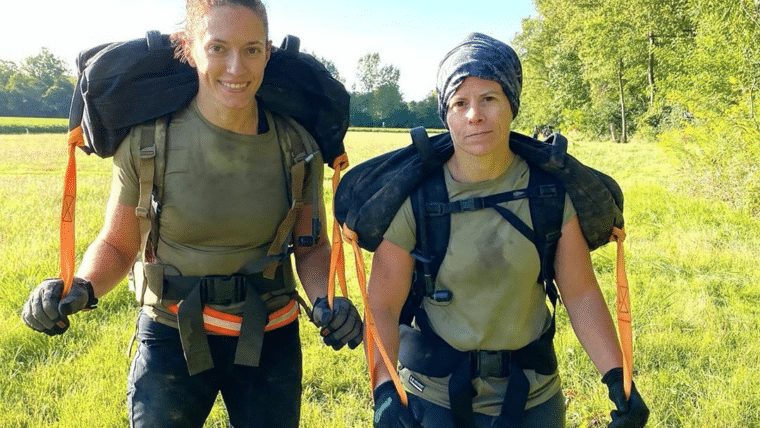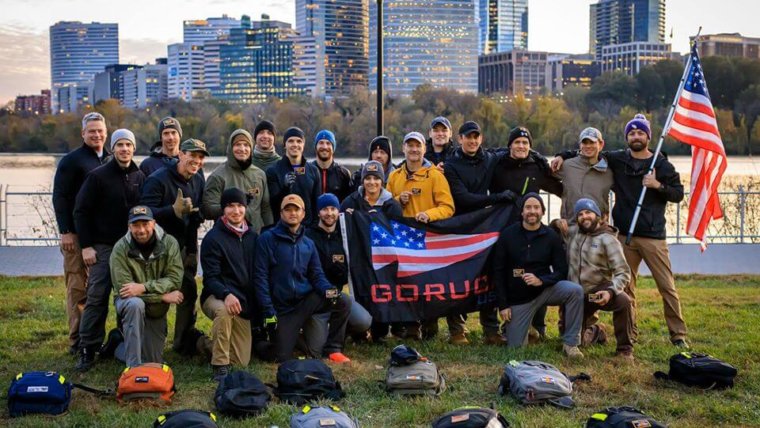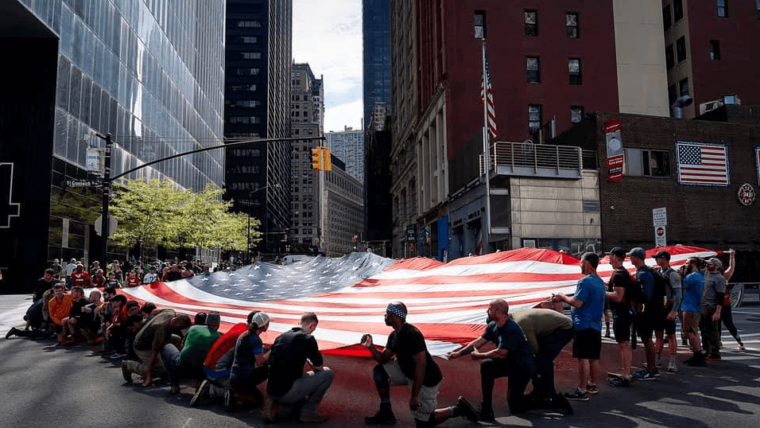
GORUCK Wilderness is a 48 hour event where the Cadre facilitate training on survival skills. The Cadre will teach fire starting, water procurement, land navigation and shelter construction. These are the basic skills necessary to survive and thrive in the wilderness. The last part of the event we run teams through a lane where we have you put the skills you learned to use.
Click here to find the next Wilderness 48 Event
Below was written by Caitlin Eiben after her recent Wilderness 48 experience. Photos courtesy of Eric Perry, IG @steel.city.shadow!
GORUCK Wilderness 48
- Date/Time: 12 JAN 2024 @ 1200 to 14 JAN 2024 @1207
- Location: Stony Point, NY- Camp Bullowa
- Cadre: Norwich, Cadre Steve, and honorary Cadre Coco
Weather:
- Friday: High 47, Low 29. Partly cloudy during the day. Steady, heavy rains overnight starting at 2200-0700
- Saturday: High 54, Low 32. Partly cloudy, high winds.
- Sunday: High 37, Low 21. Partly cloudy, high winds
Gear:
- The gear list was provided over two months prior to the event and was very detailed.
- We were able to bring a ruck and basically as many additional bags as we needed to store in the cabin.
- At this specific location, there was potable water, but some people brought their own additional water for refills.
- We were able to cook dehydrated food at certain times. It is suggested to also bring snacks and larger items that do not require boiling water.

TL; DR, since I tend to get a little wordy.
Reasons to do a GORUCK Wilderness Event:
- If you like being outdoors, camping, backpacking, etc.
- If you’re looking to expand your survival skillset in a safe and non-intimidating environment.
- If you enjoy learning from highly knowledgeable individuals
- If you aren’t interested in the physical aspect of regular GORUCK Challenge events, but still want to be a part of the community.
At the end of this novel, you will find a brief AAR.
I hope this helps shed some light on the expectations of a GORUCK Wilderness event. The main takeaway I have is that I continue to leave every GORUCK event that I’ve completed feeling fulfilled but wanting more. This one was no different. In fact, I’m more eager to return to a Wilderness event since it was so incredibly educational.
I already have the summer event in my calendar, and I hope you see you there! (26-28 July in NY)
Background:
For those that don’t know me, my name is Caitlin Eiben. I am a GRT from Pittsburgh, PA. At the time of writing this, I am 96 events into my GORUCK career. I have done everything from Scavengers to Team Assessment. I have a few other event summaries, tips, etc. on Ruck.Beer (check them out), so maybe you have read some of my stuff before.
While I do not consider myself a “writer,” I do know that I like to write things down to remember them later. So that is what I’m doing. I believe the “survival” or “wilderness” events have some confusion surrounding them, so maybe me sharing my experience will help clear up the expectations of events in this series.
These events started out as custom events organized by a GRT. They were previously called Survival Double Heavies. Cadre Dan recently took them over and is basically running them as a cadre custom event. He chose Norwich to lead the events. They are now called Wilderness events, with Wilderness 48 being the 48-hour event.
Prep:
When the survival/wilderness types of events started, I didn’t have much interest in it. I enjoyed the Challenge events with the physical beatdown. I didn’t really want to have to “think” at events. I prefer the grind of just physically pushing myself. I also just felt like I’d be out of my element. I literally have never been camping in my life, until I changed that in October 2023. I knew nothing of land nav, shelter building, fire-starting, etc.
With the decrease in GORUCK events, I decided that backpacking was going to be my new substitute. This would include overnight trips. So, I gathered some fellow Steel City Ruck Club members, and we started backpacking and camping. I realized my very limited skills could use some work. Expanding my skills at the Wilderness 48 would make my trips not only more comfortable, but safer.
I started dabbling with fire-making at home. The goal was to learn to build a fire with minimal external tools. While I’m most definitely not a master, I do feel my skills have significantly increased enough to confidently build a fire in “normal” conditions.
I knew Land Nav was going to be a portion of the event, so I Googled how to use a compass and watched a few YouTube videos. I was most definitely a novice, but at least now I understood some terminology and basic concepts.
Other than that, the only other prep I did was read the Wilderness Life Support book that Cadre Norwich sent us electronically. This event had a strong focus on becoming Wilderness First Aid certified, so I knew it was a good idea to do my homework. Fortunately, as a Physical Therapist in an acute care hospital setting, the medical information was easy to absorb. There were most definitely new concepts to learn, but overall, it was easy to get through without feeling overwhelmed with information. My favorite tip was to not do CPR on someone with an obvious decapitation.
Click here to find the next Wilderness 48 Event
Hours 0-12
We started our journey on Thursday at 1800. I traveled with Belinda and Eric from Steel City Ruck Club. Belinda was participating, and Eric was shadowing. Belinda had to work Thursday, so we had a late start to our seven-hour road trip. Thanks to eight shots of espresso, we made the trip there smoothly. For those worried about my cardiac integrity, no, I didn’t actually drink all eight shots. It was nice to have some left in the morning.
People started rolling in around 1100. We mingled and organized our equipment in the cabin. We all agreed that there were no pre-event nerves that you normally experience at Challenge events. The atmosphere was organized, but very laid back.

At 1200, we were told to bring everything except our sleeping gear and clothes outside. We went over the gear list, like at a normal event, holding up objects as the cadre called them out. Everyone has what they need, so we move on to cadre introductions.

Our special guest, Coco, has a resume so long that Cadre Steve hid behind his truck in shame because he could not compete with her accomplishments.
All joking aside, all three of them were more than qualified to teach us skills needed to survive in the wilderness. I was excited to learn from them.
We introduced ourselves and then we headed up to our camp area. Earlier in the day, Norwich set up some shelter examples. He briefly showed us around and then Cadre Steve started the event off with a lecture about stress and how to manage it. We learned tips on how to react to stressful situations in a wilderness setting, which obviously also has carryover into the everyday world.

We take some notes and then move on to a fire-making demonstration. Cadre Steve showed us some different options on how to build a fire, stressing that preparation is going to account for most of your success. He informs us that on Sunday we will be tested. We will have 15 minutes to start a fire and get a half of a cup of water to a rolling boil. I’m excited to give it a whirl.

From here, we get a knot tying demonstration and get to practice. We are shown how they are used in various shelter set ups. We are given about an hour to go find a location with our team to set up camp in our group.

My group, N2B, consisted of myself, Belinda, and then Taylor and Ryan from Burning River Ruck Club in the Cleveland Area. We also adopted our shadow, Eric, who decided he wanted to stay outside overnight instead of staying in the cabin.
Since it’s supposed to be rainy, cold, and windy, we decided that making one large shelter was the best option instead of all of us making individual shelters. We find two trees on flat ground and create a lean-to. I did all of the lashings, so the pressure was on to make sure it didn’t collapse on us overnight. We fill it with leaves for insulation and find some logs and rocks to secure the bottoms of the tarps. We had one tarp over the top and then two tarps angled out on the sides. Everything seemed pretty taut and secure. We were proud of our set up and headed back to the cabin.



From here, we head down to a classroom at the other end of Camp Bullowa. Coco is inside and we take seats at the tables. We are introduced to the main course of the weekend, Wilderness First Aid training.
We find out that first aid training is just a bunch of acronyms. I’m kind of kidding, but mostly serious.
We were given a laminated cheat sheet with AVPU, MARCH, AEIOUTIPS, SAMPLE, CARTS, and some others. My favorite was CARTS, which was to help to identify areas of major sources of bleeding. It includes Chest, Abdomen, Renal, Thigh, and Street. We all got confused when we got to Streets, so we decided it meant street gangs. It ended up just being a typo, but I’m still going with backwoods street gangs.


Before the event began, Coco asked me and Belinda to be her “victims” so she could demonstrate how to perform an assessment. I was assigned as being hypoglycemic. I was cued to be a confused, wandering individual that gets agitated upon approach. Belinda had abdominal pain due to an ectopic pregnancy, responsive only to painful stimuli.
I went first.
I committed to my role the best my acting skills allowed. I was desperately searching for my turtle. I got dizzy and had to sit on the ground. I swatted and yelled at Coco as she approached me. She backed off a bit and approached cautiously. She tried to get some information out of me. Most importantly, asking when I last ate, to which I replied, “I don’t know, a few months ago.” This cued her into me possibly being hypoglycemic and she offered me a snack. I recovered quickly and the day was saved!
No one found my turtle, though, so that was a bummer.
We started doing group scenarios. Coco would take some of us out to be actors. She would brief them on their condition and then we would go out in small groups and find the victims and attempt to diagnose and treat them.
The scenarios were a great learning experience and hilarious at the same time. Everyone really embraced the acting portion, which made the class way more enjoyable. I swear, I enjoyed the classroom work and learned a lot.

We were cut from class around 2100 and told the rest of the evening we were on our own time. We are to be back at the cabin at 0500 and in the classroom at 0530.
We were allowed to have our phones on us, so I checked the weather. It was supposed to start raining in about an hour. We have about a half mile walk to the cabin, have to pick up our sleep supplies and some other gear that Norwich left for us. Important things like M&Ms. We also have to chop and bring up firewood from the entrance to the cabin to the camp, which is even further away.

We decided to split up. Eric, Belinda, and I headed to camp. I am confident that I can get a fire going and maintain it with kindling until Ryan and Taylor arrive with the larger firewood.
We grab our sleep supplies from the cabin and head up. I immediately started on the fire. When we set up our shelter, we were also already starting to collect kindling, and we made a little firepit with rocks. We had a tarp over it in case it rained. So, +1 to us for thinking ahead and being prepared.

I break out my fire-starting supplies and quickly get one started. It was very easy to maintain until Ryan and Taylor arrived with the firewood. We start boiling water for our dinner. The last thing of substance I ate was my breakfast sandwich, so I was ready to eat. Belinda took this lovely photo to document the monumental event of eating hot food.

As soon as I was done, it began to rain. It started coming down pretty hard. Fortunately, everyone already had their sleep systems set up and their gear put in contractor bags.
Norwich told us that if we wanted to keep a fire going throughout the night, at least one person had to stay awake to be on fire watch. I decided to take the first shift. I stood out in the rain for a while, but then decided to just sit in the shelter staring at the fire, while everyone else started to drift off to sleep.
The rain was pouring down. The fire needed some maintenance, so I went out and looked for more kindling. The larger pieces of wood were having trouble catching fire. The wet kindling quickly caught, and the fire was going strong again. I returned to my spot in the shelter and sat there for another 45 minutes or so.
Click here to find the next Wilderness 48 Event
Hours 12-36
I see something in the distance. I can’t hear anything other than rain, but there is definitely someone moving towards us. I whisper to Eric, who is next to me, that we have an intruder. Cadre Steve pops his head in.
I greet him, tell him I’m on fire watch and overall, we are doing great. He mentions that if things get really bad, we can go down to the cabin. At least, I think that’s what he said. It was pouring so hard on the tarp; it made it hard to hear.
He leaves and the fire is dying down. Since Eric is awake, I get his opinion on if I should actually wake someone up to take the next shift, or just sit here until it goes out. I am 99.9% sure that no one wants to go out in the rain to search for kindling, as the larger logs were still having trouble catching.
We decided it would be fine to let it go out. It was plenty warm in the shelter and the only thing we’d need the fire for in the morning would be for boiling water for food, which we likely wouldn’t want to do anyway since the forecast brought the rain all the way until after sunrise.
I decided I’m going to go to sleep and let the flames go out with help from the rain.
I fall into a pretty good sleep, until I hear a voice. It’s Taylor saying, “it’s starting to leak. My bag is getting wet.”
Ryan turns on his headlamp and we see some dripping from the corner of the tarp. We look up and see multiple huge bulges in our main tarp. The rainwater is collecting and starting to drip between the tarps.
At this point, it is manageable. It is 0400 and we have to be up around 0445, but even 45 minutes was way too long to just ignore it and hope for the best. I grab my boots, put them on the wrong feet, and reach for my rain jacket. I find that it is also soaked, despite technically being under the tarp. I go out without my jacket and hold the edges of the tarp taut while they push out the bulges of water and let them run down the back of the shelter. I go to the other side and do the same thing.
I was outside for maybe 1-2 minutes, and I’m completely soaked. I crawl back in my sleeping bag and try to go back to bed, but before I know it, my alarm goes off.
Since we always must travel in a buddy system. I wake everyone up and tell them my plan to move out quickly. I don’t want to be ready to go and then have to wait for everyone else. I get up, put my shoes on the correct feet. Grab all the layers I can find out of my ruck and throw my sleep system in the contractor bag to take it back to the cabin.
We warm up in the cabin and change layers. We are told we have to be in the classroom at the other end of the camp by 0530. We collect our things for the day and walk the half mile in the rain to the classroom.
We start our learning where we left off. We do more scenarios and lectures.

After that, we head to a pavilion and get basic compass lessons with the help of some pizza boxes. I’m glad it was broken down in layman’s terms because my YouTube video knowledge was already leaving my brain.



Ryan has some experience in land nav, so it was great to have him in our group. Once I understood the basic concepts, I would plot the points first and then he would double check my work.
We headed back again to the classroom for continued WFA training. This time, we learned different splinting and treatments for musculoskeletal trauma. I was put in a C-spine collar made from a SAM splint that was actually pretty comfortable once it wasn’t digging into my trachea.
We do more scenarios and then go back into the classroom and discuss our evaluations and treatments. We also set up and utilized some extraction devices.


From here, we head back to the pavilion and start our actual land navigation practice. After some correction, we find the correct location, distance, and azimuth. Pro tip: it helps when you use the correct scale.

On our way to our second point, we saw a flock of vultures eating a carcass, so that was neat. Belinda had a stumble on the way back and hit her shin on a rock. Between that and then vulture hunting, we arrived a little late back to the pavilion, so we were not provided with a third point. We hung back and waited for the other teams to arrive back.


Back to the classroom we went.
We finished the book by discussing some bites and stings, evacuation guidelines, and triaging.
We do more scenarios. This time we are not in a group. We split up into two groups. One group act as victims first, while the others are the medical providers, then we switch.


Everyone has a unique ailment.
I evaluated a pelvic fracture. She fell off her bike, A&O x 4, a lot of pain in her bilateral pelvis, starting to get cold. I had to “run” to the Ranger office to get appropriate tools to stabilize her pelvis AKA two jackets. I also grabbed a sleeping bag to keep her warm. I said in theory, I would have constructed a litter to take her to the Ranger office if there were people available to assist, and we would wait for the helicopter there while we continued to monitor her vital signs. If that was unable to occur, we would stay in the field and attempt to maintain her temperature and comfort while we waited for a helicopter.
Now it was my turn to be the victim. I was given the assignment of a person who just had a stroke. Fortunately, as a physical therapist in a hospital, I am highly familiar with the symptoms of a stroke. I decided to have a right MCA infarction. So, left sided weakness, impulsive, decreased insight into my condition, facial droop, aphasia, etc.
Glen found me stumbling down the road, dragging my left leg. He initiated conversation and I started saying nonsensical things with a left facial droop. He asked me many appropriate questions, but unfortunately for him, my answers didn’t make sense. He brought me inside, helping me walk, as my left leg kept dragging. He had me sit in a chair. My left arm fell to the side, and I slumped over to the left. After controlling our laughter from me continually speaking with a facial droop, he concluded that I had a stroke. Ding ding!
We briefly summarize what we learn and are then instructed that we are about to go off to our final exercise, which will include combining our land nav skills with our WFA training. We get to go back to the cabin to eat and prep first.
Four of us were instructed to stay back, me, Belinda (former EMT), Adam (paramedic), and Mark DD. Given that we had some medical background, we were chosen to be the victims in a mass casualty event.
Our assignments and scenario were provided. We were victims of a rockslide after an earthquake. My “husband,” Adam, was unfortunately knocked unconscious. He injured his C-spine and had a morbid open femur fracture. He was instructed to hold his breath until they checked for breathing and provided rescue breaths, then once they did that, he became minimally responsive but a little agitated.
I, fortunately, only fractured my arm. Otherwise, I was alert and oriented. I was cued to be anxious and panicked. They were supposed to realize that since I had a good arm, I could actually help with extraction.
We got into our places and waited for them to perform the land nav portion of the exercise. I was told once I can hear their voices clearly, I could start “calling for help.”

I summoned all my acting skills, which basically equated to Michael Scott doing improv. I got into the character of a rich, entitled hiker with a history of anxiety, exacerbated, of course, by my current situation.
I started yelling for them. I sarcastically told them to take their time. Once they were closer, three of them approached me and the others went to my “husband,” as I was screaming for him.
They start evaluating me, asking me orientation questions, all of which I answer correctly, as if they were annoying me. I told them my arm hurts really bad. They did a brief assessment and splint it with my own shemagh. I yell at them for using my $300 scarf to splint my arm. They kindly tell me to suck it up. I immediately started trying to get up to find my husband. They attempt to get me to sit down and complete their assessment. I’m adamant that I am fine, except for my arm. I get up and see my husband and start screaming because all I see is blood and his bone sticking out of his leg.
At this point, they have no idea he is supposed to have an open femur fracture, because he was unresponsive and not able to give them cues.
Since I was a hysterical, crazy lady already, they didn’t believe me that he had the open femur fracture. They consulted with Cadre Norwich, who confirmed that I was providing accurate information.
They quickly place a tourniquet on the leg and continue to work on his C-spine with a SAM splint. They place him on a litter, and I scream as obnoxiously as possible every time I see his neck or leg move. I threaten to sue them if he loses his leg or dies. I continually try to get in their way. Glen attempts to bring me aside and pull me away from the situation. I heard him call me some undesirable names under his breath, though.
I do admit that I took out a $3 million dollar insurance policy right before this trip, however, so they were suspicious as to my investment in their success.

When it comes to moving him to the helicopter location, someone says out of character to me about how they wish I could help move the litter. I mention to them that I do have a good arm and that I’m allowed to help. So, I grabbed some rope, and we helped move him to a lean-to shelter and waited for the helicopter.
Two people stay back while the rest of the group goes up to help the team working on Belinda and Mark DD.
Once Belinda is brought down, I yell that my husband and I get first priority on the helicopter.
Belinda tells me that she could clearly hear me screaming from her point way up the hill.
We all started laughing.
I go in and out of character until the simulation is completed. We are fairly sure Adam and Mark DD did not survive the rockslide, and I’m also fairly sure everyone wants to just leave me out in the wilderness.
We are told the rest of the night is on our time and our wake-up call is 0530.
The five of us headed to our camp. I offer to give fire-building lessons with my limited skills and knowledge. We get another small one going, and I attempt to get the water boiling in 15 minutes. I had some bubbles, but I would not say it was a rolling boil. I have some things I want to change for the test regarding the set-up of the cup, but I think I can get it.
We let the little fire go out. It’s windy and colder than it was the night before, but there’s no rain and still fairly warm in the shelter. There were some areas of the shelter that needed tightened due to the crazy winds, but overall, it held up very well.

Oh, except my Tyvex ground sheet was nowhere to be found. I left it in the shelter, thinking it was deep enough in there that it wouldn’t blow away. I was wrong. I did a brief sweep of the area, but I didn’t find it. Oh well. I mostly just had it to keep my sleeping pad clean.
We crawl into our sleeping bags and fall asleep. We are pretty excited to have seven hours to try to get some sleep. While the physical aspect of this event isn’t that strenuous, the mental aspect is a lot, and we are all very tired.
Click here to find the next Wilderness 48 Event
Hours 36-48
I shift around often. I was toasty, except my face. Every now and then I tucked my head in my sleeping bag until I warmed back up. At one point in my shifting, I noticed a red light coming towards our tent. I see that it is Cadre Norwich. He is checking on us. Eric woke up as well. We confirm that we are doing just fine. He leaves and we go back to bed.
My alarm goes off at 0530. I feel bad waking everyone up, but someone had to do it. I turn on my headlamp and start putting my layers back on. We are told that we have until 0630, but if we are able to take down our shelter, we should do so. We get it all taken down and replace everything back to where we found it. When we are done, you would have had no idea that we had a 5-person shelter and fire pit there just 30 minutes prior.
We headed back to the cabin. We are the first group there. I start to pack up my sleeping gear as the other groups wander in.
At 0630, we are told to break into three groups for a service project. The group I went into ended up being the log splitting group. The other two groups are on cleaning duty.
I’m not confident in my ax swinging ability. Not so much the swing, but the accuracy, which makes me not feel confident to swing as hard. I gave it a few tries, but after hearing the foot splitting horror story from a previous event, I decided to stick to moving the logs to the log pile. Once extra help arrives, I give the wedge a try and find success. It’s gratifying to hear/see the split in the wood.







We get the job done and move back to the cabin for a debriefing on yesterday’s final exercise.
We discuss everything that went right and the countless things that went wrong the night before. Coco admits that she sets the scenarios up for failure and to induce stress to emphasize how difficult mass casualty events are.
From here, we are told we are doing our fire-starting test. We were given a half hour to prep. Fortunately, they gave us a heads up that we were being tested, so on the way back from chopping wood, I was collecting my kindling.
I head up to the camp where we are being tested and I find a nice rock to set up against. I have my leaves, fatwood shavings, cotton balls, and one cotton ball dipped in petroleum and wax. I have no doubt I can start the fire since this is more material than I have been using all weekend. I set up a rock and a log around my area where I can set a thin wooden plank to rest my cup on.
When the timer starts, I create a spark and a flame on my first try. The cotton ball goes up, which quickly spreads to the fatwood feathersticks and shavings. Once the petroleum and wax cotton ball ignites, I know I have some time to get my kindling going. The fire grows very quickly, and I can see the water getting warm. I got this.
Unfortunately, I listened to a suggestion to place my cup directly on the fire. While this did heat it up faster, it was too hard to maintain the fire due to the lack of oxygen. It went to embers and then boom, it was out. I had one more cotton dipped in wax left over. I get it lit and start again. I did get another fire going and some bubbles in my water, but before I knew it, time was up. Fail.




Only one person, Mark DD, passed.

I’m disappointed, because I think I could have had it if I stuck with my own strategy, but it’s ok. Live and learn.
We clean up our areas and review the fire-making task.
Now it’s time to head back to cabin to wrap up the event. We are asked to give feedback on many aspects of the events. Norwich, Steve, and Coco were very receptive to feedback, which is very important to the success of future events.
We got our patches and our Budweiser, and there you have it!

I am more than pleased with my decision to attend this event. I will definitely make it a priority to attend this style of event in the future.

AAR
Now for my attempt at an actual AAR. Yes, I had to Google what components should be included.
What was my/our mission?
- To expand survival skills and expose myself to uncomfortable situations.
What actually happened?
- I went from having literally zero land nav skills to feeling mildly confident that I could utilize a map and compass appropriately.
- I learned knot tying that I utilized to build a shelter that stayed up through harsh weather.
- I expanded my emergency medical knowledge.
- I stayed outside under a tarp in rainy and windy conditions with literally not one thought about going to the cabin.
Why was there a difference?
- There was no difference. The mission was met.
What have I learned?
- Basic land nav skills
- Knot tying
- Shelter building
- Emergency wilderness first aid
- Important first aid items to carry during time in the wilderness.
- Litter building
- Expanded on fire-making skills.
- How to be an amazing actress.
What will I do about it?
- Continue to practice land nav skills in semi-familiar territory.
- Revamp my first aid kit, especially for longer camping trips.
- Continue to practice knots and shelter building.
- Re-read the WFA book to make recall easier if I come across a situation where I need to intervene.
I know that was a lot. I write these things so I can recall my adventures later in life, but when I believe they may be useful for others to read, I like to share my stories and what I learned.
I hope you found it helpful, and if this sounds at all interesting to you, I encourage you to sign up for a future event!
